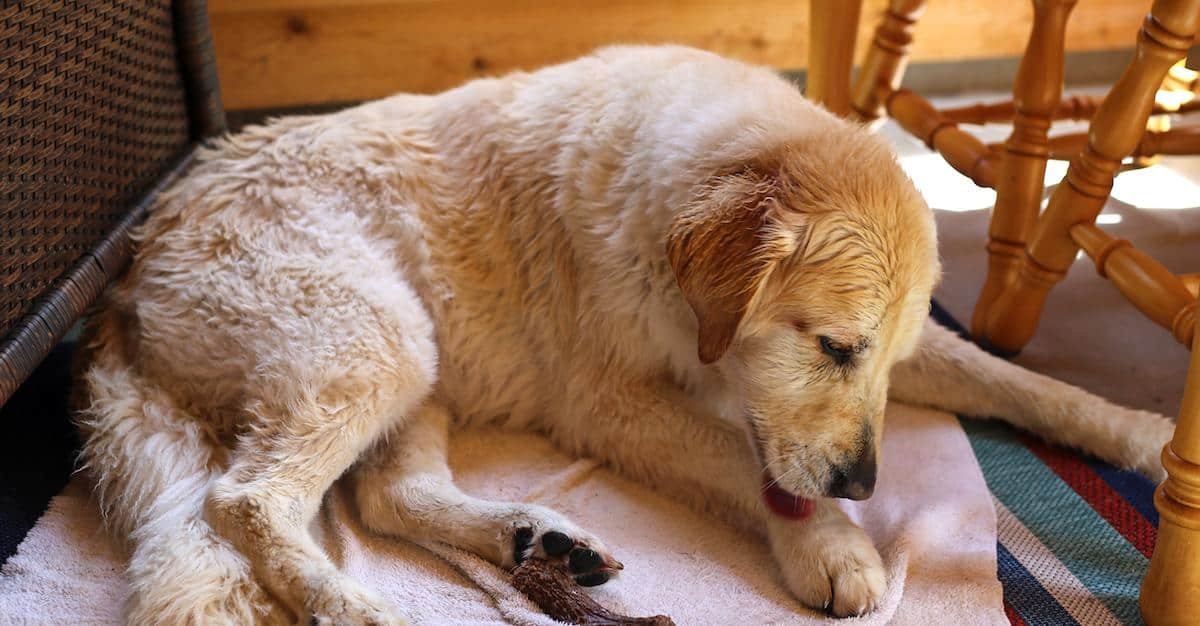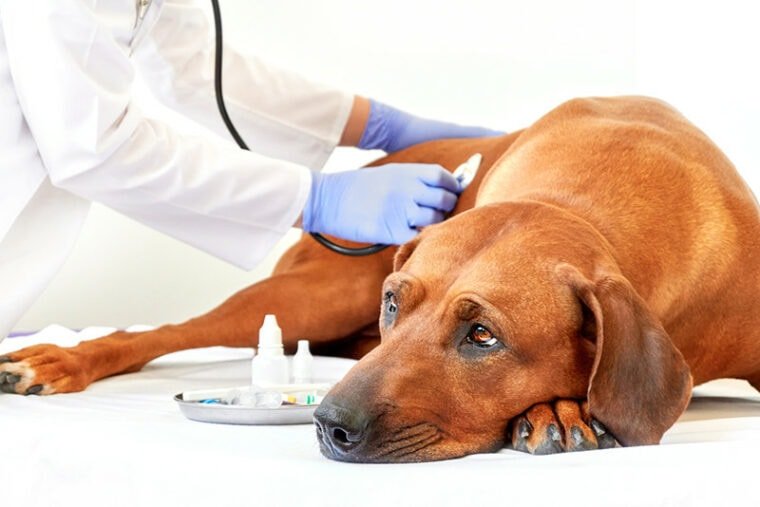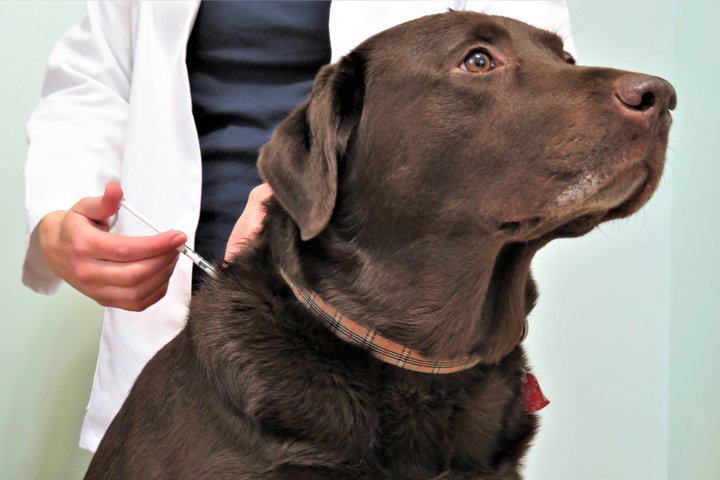How To Prevent Your Dog From Licking Paws
Why is my dog licking his paw so much?
Excessive paw licking in dogs can be a sign of various underlying issues, and it’s important to pay attention to this behavior and try to determine the cause. Here are some common reasons why dogs may lick their paws excessively:
- Allergies: Dogs can develop allergies to certain foods or environmental factors, such as pollen, grass, or dust. Allergic reactions can lead to itchy skin and paws, prompting excessive licking.
- Skin Irritation or Infection: Irritation from a foreign object, a small wound, or a cut on the paw can lead to excessive licking. Bacterial or fungal infections may also cause itching and discomfort.
- Dry Skin: Dry or flaky skin can be itchy, causing dogs to lick their paws in an attempt to relieve the irritation.
- Parasites: External parasites, such as fleas or mites, can irritate a dog’s skin and paws, leading to excessive licking.
- Pain or Discomfort: If your dog is in pain due to an injury or a musculoskeletal issue, they may lick their paws as a way of self-soothing.
- Stress or Anxiety: Dogs may lick their paws when they are stressed, anxious, or bored. It can be a self-soothing behavior.
- Boredom: Dogs that are not mentally or physically stimulated may resort to excessive licking as a way to pass the time.
- Orthopedic Issues: Dogs with orthopedic problems, such as arthritis or joint pain, may lick their paws as a response to discomfort.
- Compulsive Behavior: In some cases, excessive paw licking can become a compulsive behavior, similar to obsessive-compulsive disorder in humans.
If you notice your dog licking their paws excessively, it’s essential to investigate the cause and seek veterinary advice. Your veterinarian can perform a thorough examination and, if necessary, recommend tests or skin scrapings to diagnose the issue. The appropriate treatment will depend on the underlying cause, and it may include medication, changes in diet, or behavioral interventions.
In the meantime, to prevent your dog from causing further harm to their paws, you can use an Elizabethan collar (often called a “cone” or “e-collar”) to prevent access to the paws and reduce the temptation to lick. However, this is a temporary solution, and addressing the root cause of the behavior is essential for long-term improvement in your dog’s well-being.
What can I put on dog to stop licking?
If your dog is excessively licking a specific area due to irritation, injury, or a medical condition, it’s essential to address the underlying cause. However, to prevent further licking and to protect the affected area, you can use certain products or strategies. Here are some options:
- Elizabethan Collar (E-collar or Cone):
- Using an Elizabethan collar, commonly known as an E-collar or cone, is one of the most effective ways to prevent a dog from licking a specific area. These collars are designed to prevent the dog from reaching the affected body part, allowing it to heal.
- Anti-Lick Strips or Sprays:
- There are various commercial anti-lick strips or sprays available that can be applied to the affected area. These products often have a bitter taste or scent that discourages licking.
- Bitter Apple Spray:
- Bitter apple spray is a common product used to deter dogs from licking or chewing on surfaces. It has a taste that dogs typically find unpleasant. Apply it to the affected area following the product’s instructions.
- Topical Ointments:
- Some veterinary-approved topical ointments or creams can be applied to the affected area to discourage licking. Consult with your veterinarian to determine the most suitable product for your dog’s condition.
- Covering the Area:
- If the licking is focused on a specific body part, you can cover the area with a pet-friendly bandage or wrap. Make sure it’s applied securely but not too tight to allow for proper circulation.
- Behavioral Modification:
- Identify and address the underlying cause of the excessive licking. If it’s due to stress, boredom, or anxiety, consider behavioral modification techniques or provide mental and physical stimulation for your dog.
- Consult with a Veterinarian:
- If your dog’s licking persists or is accompanied by signs of pain, redness, swelling, or discharge, consult with your veterinarian. There may be an underlying medical issue that needs attention.
It’s crucial to use safe and vet-approved products and to consult with your veterinarian before applying any topical treatments. Some products may not be suitable for certain skin conditions, and your veterinarian can provide guidance based on your dog’s specific needs. Additionally, addressing the root cause of the licking is essential for long-term solutions.
Can I put coconut oil on my dogs paws?
Yes, you can apply coconut oil to your dog’s paws, and it can offer several benefits. Coconut oil is known for its moisturizing and soothing properties, and it can be particularly helpful for dry or cracked paw pads. Here’s how you can use coconut oil on your dog’s paws:
- Apply Small Amounts:
- Use a small amount of coconut oil on your fingers and gently massage it onto your dog’s paw pads. Be sure to apply it sparingly to avoid making the paws too slippery.
- Focus on Dry Areas:
- Concentrate on any dry, rough, or cracked areas on the paw pads. The moisturizing properties of coconut oil can help soften and hydrate the skin.
- Prevent Licking:
- Keep in mind that dogs may be tempted to lick their paws after you apply any substance. If your dog tries to lick the coconut oil, you can distract them with play or offer a treat to give the oil some time to be absorbed.
- Use as Needed:
- You can apply coconut oil to your dog’s paws as needed, especially during dry or harsh weather conditions that can contribute to paw pad dryness.
- Consult with Your Veterinarian:
- If your dog’s paw issues persist or if you have concerns about their paw health, it’s advisable to consult with your veterinarian. They can help identify any underlying issues and provide guidance on appropriate treatments.
Coconut oil is generally safe for dogs when used topically or as a dietary supplement. It contains lauric acid, which has antimicrobial properties and can be beneficial for the skin. However, every dog is different, and some may have allergies or sensitivities. Always monitor your dog for any adverse reactions, and discontinue use if you observe any signs of irritation.
It’s worth noting that while coconut oil can be applied topically, it should be used in moderation, and excessive ingestion can lead to digestive upset due to its high-fat content. If you’re considering adding coconut oil to your dog’s diet, consult with your veterinarian for appropriate guidance based on your dog’s individual needs.
What are natural remedies for dogs licking?
If your dog is licking excessively, it could be due to various reasons, including allergies, skin irritation, boredom, anxiety, or underlying health issues. While addressing the root cause is essential, there are some natural remedies that may help manage excessive licking in dogs:
- Coconut Oil:
- As mentioned earlier, coconut oil has moisturizing properties and can be applied to dry or irritated skin. It’s safe for dogs to lick in small amounts. Apply a small amount to affected areas, but monitor for any adverse reactions.
- Aloe Vera:
- Aloe vera gel, especially the natural, non-toxic variety, can be soothing for irritated skin. Make sure the aloe vera product you use is safe for dogs, and apply a thin layer to the affected area.
- Oatmeal Soaks:
- Oatmeal has anti-inflammatory properties and can be beneficial for soothing itchy skin. You can prepare an oatmeal soak by mixing finely ground oatmeal with water and applying the paste to your dog’s skin.
- Chamomile Tea:
- Chamomile has anti-inflammatory and calming properties. Brew chamomile tea, let it cool, and apply it to your dog’s skin using a clean cloth. Alternatively, you can add chamomile tea to your dog’s bath.
- Apple Cider Vinegar (ACV) Rinse:
- Dilute apple cider vinegar with water (1:1 ratio) and use it as a rinse on your dog’s skin. ACV has antimicrobial properties and may help soothe irritated skin. Avoid using on open wounds.
- Omega-3 Fatty Acids:
- Omega-3 fatty acids, found in fish oil supplements or fatty fish like salmon, can promote healthy skin and coat. Consult with your veterinarian for the appropriate dosage for your dog.
- Probiotics:
- Probiotics can support a healthy immune system and gut, which may, in turn, have positive effects on your dog’s skin health. Consider adding a canine-specific probiotic to your dog’s diet.
- Environmental Enrichment:
- Provide mental and physical stimulation for your dog to reduce boredom and anxiety. Interactive toys, puzzle feeders, and regular exercise can help keep your dog occupied and content.
- Regular Grooming:
- Keep your dog’s coat clean and well-groomed. Regular brushing can help remove loose hair and reduce the risk of skin irritation. Here is the article I wrote about grooming your dog at home.
- Consult with a Veterinarian:
- If your dog’s licking persists or is accompanied by signs of discomfort, redness, swelling, or other concerning symptoms, consult with your veterinarian. They can help identify the underlying cause and recommend appropriate treatments.
It’s important to note that while these natural remedies may offer relief, they should not replace professional veterinary advice. Always consult with your veterinarian before trying new remedies, especially if your dog has pre-existing health conditions or is on medication.
Is it possible to stop a dog from licking?
While it may be challenging to completely stop a dog from licking altogether, especially considering that licking is a natural behavior for dogs, it is possible to manage and reduce excessive licking through various strategies. The key is to address the underlying cause of the licking and employ positive and preventive measures. Here are some approaches to consider:
- Identify and Treat the Underlying Cause:
- Excessive licking can be triggered by various factors, including allergies, skin irritation, anxiety, boredom, or underlying health issues. Identifying and addressing the root cause is crucial. Consult with your veterinarian to determine the underlying issue and develop an appropriate treatment plan.
- Behavior Modification:
- If licking is associated with stress, anxiety, or boredom, consider behavior modification techniques. Provide mental and physical stimulation through interactive toys, puzzle feeders, and regular exercise. Establish a routine to create predictability for your dog.
- Use of Deterrents:
- Apply safe deterrents to areas where your dog tends to lick excessively. Bitter-tasting sprays or gels can be applied to surfaces to discourage licking. Always use products that are safe for pets and consult with your veterinarian.
- Provide Distractions:
- Redirect your dog’s attention to alternative activities when you observe excessive licking. Offer toys, treats, or engage in interactive play to distract them from the behavior.
- Use of Protective Measures:
- If your dog licks a specific area on their body, consider using protective measures such as an Elizabethan collar (E-collar or cone) to prevent access to the area. This allows time for healing and reduces the likelihood of further irritation.
- Regular Grooming:
- Keep your dog’s coat clean and well-groomed. Regular brushing can help remove loose hair, reduce skin irritation, and prevent mats or hot spots.
- Medical Intervention:
- In some cases, medication or prescription treatments may be recommended by your veterinarian to address underlying medical or behavioral issues contributing to excessive licking.
- Professional Behavior Training:
- Consult with a professional dog trainer or behaviorist to address any underlying behavioral issues contributing to excessive licking. Positive reinforcement training techniques can be used to modify behavior.
It’s important to approach the issue of licking with patience and understanding. Punishment is not recommended, as it can lead to stress and anxiety in your dog. Instead, focus on positive reinforcement, preventive measures, and seeking professional guidance when needed.
If excessive licking persists or is accompanied by signs of discomfort, inflammation, or other concerning symptoms, consult with your veterinarian for a thorough examination and appropriate guidance.
Why does my dog lick his paws at night?
Excessive licking of paws, especially at night, can be indicative of various underlying issues. While occasional paw licking is normal, persistent or excessive licking may be a sign of discomfort, irritation, or an underlying health problem. Here are several potential reasons why your dog may be licking his paws at night:
- Allergies:
- Dogs can develop allergies to environmental factors (pollen, dust mites), food ingredients, or even certain materials. Allergies can lead to itchy paws, prompting your dog to lick them for relief.
- Skin Infections:
- Bacterial or fungal infections on the paws can cause irritation and discomfort, leading to excessive licking. The moist environment created by licking can further exacerbate the issue.
- Dry Skin:
- Dry or cracked skin on the paws can be itchy and prompt your dog to lick in an attempt to soothe the discomfort. Weather conditions, such as low humidity, can contribute to dry skin.
- Pain or Discomfort:
- Pain or discomfort in the paws or limbs may lead to licking as a self-soothing behavior. Arthritis, injuries, or orthopedic issues could be contributing factors.
- Anxiety or Stress:
- Dogs may exhibit stress or anxiety through behaviors like excessive licking. Changes in routine, new environments, or other stressors can contribute to this behavior.
- Insect Bites or Stings:
- If your dog has been exposed to insects or pests, bites or stings can cause itching and discomfort, leading to paw licking.
- Behavioral Habit:
- Some dogs develop paw licking as a habitual behavior, especially if they find it comforting. This can become a self-reinforcing cycle.
- Gastrointestinal Issues:
- Some gastrointestinal issues, such as inflammatory bowel disease, can manifest with skin-related symptoms, including paw licking.
If you notice your dog licking his paws persistently, especially at night, it’s advisable to consult with your veterinarian for a thorough examination. Your veterinarian may perform tests, such as skin scrapings, allergy testing, or bloodwork, to identify the underlying cause.
In the meantime, you can try the following:
- Regular Paw Inspections: Check your dog’s paws for signs of redness, swelling, cuts, or foreign objects.
- Maintain a Clean Environment: Keep your home environment clean and free from potential allergens or irritants.
- Use an Elizabethan Collar (E-collar): If licking is causing further irritation, an E-collar can prevent access to the paws temporarily.
Addressing the root cause of the paw licking is essential for effective management. Once the underlying issue is identified and treated, the excessive licking behavior should diminish.








